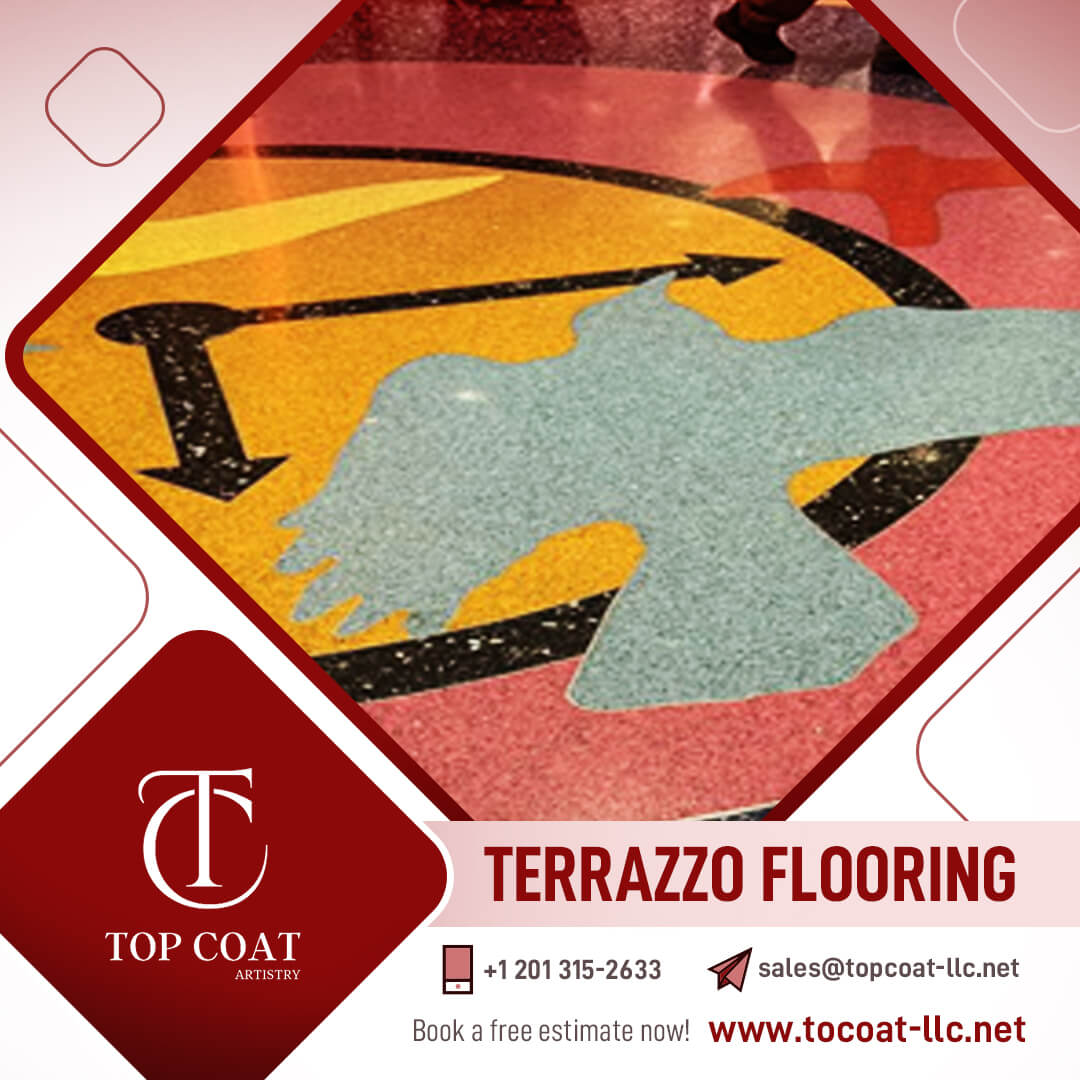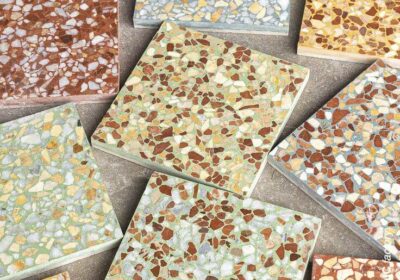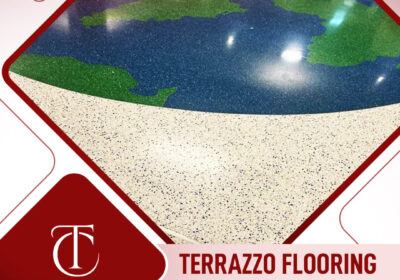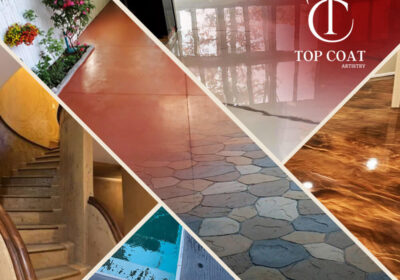Terrazzo Flooring: Advantages & Disadvantages & What You Need

Terrazzo Flooring: Advantages & Disadvantages & What You Need.
When it comes to choosing a flooring material that combines both aesthetic appeal and long-lasting durability, few options can compete with terrazzo. Originating in Italy in the 15th century, terrazzo flooring has become a staple in public spaces, commercial buildings, and increasingly, residential properties. Characterized by its intricate patterns and the seamless integration of materials like marble, quartz, granite, or glass chips, terrazzo offers an unmatched aesthetic versatility.
However, like any flooring option, terrazzo comes with its set of advantages and disadvantages. Understanding these can help you make an informed decision when deciding if terrazzo is the right fit for your home or business.
In this article, we’ll break down the pros and cons of terrazzo flooring, discuss its maintenance, cost, lifespan, and compare it to other flooring materials. By the end, you’ll have all the information you need to determine whether terrazzo is a viable option for your space.
What is Terrazzo Flooring?
Before diving into the pros and cons, it’s essential to first understand what terrazzo flooring actually is. At its core, terrazzo is a type of decorative flooring made by mixing a binder (either cement or epoxy resin) with aggregates like marble chips, granite, quartz, or glass. This mixture is poured into place and polished to create a smooth, durable surface with distinctive patterns and textures. Terrazzo flooring is customizable and can be designed in various styles, from traditional to modern, depending on your preferences.
Terrazzo is often referred to as a green flooring option because many terrazzo systems use recycled materials, making it an environmentally friendly choice for sustainable building projects. It’s commonly used in high-traffic areas such as airports, museums, shopping malls, and schools, where durability and low maintenance are essential.
Advantages of Terrazzo Flooring
There are many reasons why terrazzo flooring is favored in both commercial and residential applications. Let’s explore the main benefits of terrazzo that make it stand out from other flooring materials.
1. Durability
One of the key benefits of terrazzo flooring is its exceptional durability. When properly installed, terrazzo can last the lifetime of a building. Unlike wood, carpet, or vinyl flooring, terrazzo does not need to be replaced every few years. It is highly resistant to abrasion, staining, and scratching, making it an ideal choice for areas with heavy foot traffic.
Terrazzo’s resilience is largely attributed to the hard, dense surface that is created when the aggregates are bonded to the binder and polished. In commercial buildings, this long-lasting quality ensures that the floors remain in excellent condition for decades, reducing the need for frequent replacements or repairs.
2. Low Maintenance
Another major advantage of terrazzo flooring is its low maintenance requirements. Unlike some flooring materials that require regular waxing or sealing, terrazzo floors are relatively easy to maintain. Routine cleaning typically involves sweeping or vacuuming to remove dirt and debris, followed by mopping with a neutral pH cleaner to maintain its shine.
For many commercial properties, this ease of maintenance translates to cost savings over time since terrazzo doesn’t require frequent refinishing or intensive cleaning products. Additionally, terrazzo is non-porous when properly sealed, so it doesn’t stain easily, making it ideal for high-traffic or food service areas.
3. Design Versatility
One of the most attractive features of terrazzo flooring is its design versatility. The variety of aggregate materials available means that terrazzo floors can be customized to fit any aesthetic or design theme. Whether you want a sleek, modern look with glass chips or a more traditional feel with marble chips, terrazzo can accommodate any design vision.
In addition to the materials, terrazzo flooring can also incorporate different colors, shapes, and patterns. This customization allows for creative freedom, making it a great option for designing unique spaces. You can even create mosaic patterns and add logos or branding to the floor in commercial applications. Terrazzo is often seen as a premium flooring option because of its ability to create stunning visual impact.
4. Refinishable
Another major advantage of terrazzo is that it is refinishable. Over time, if the floor begins to lose its luster or shows signs of wear, it can be sanded down and polished to restore its original shine. This makes terrazzo a great long-term investment, as it can be restored multiple times, extending its life for decades.
Additionally, since terrazzo is a poured-in-place flooring system, there are no seams or grout lines, which means there are fewer places for dirt and grime to accumulate. This feature contributes to the floor’s hygienic nature, as it’s easier to keep clean compared to tile or wood flooring.
5. Environmentally Friendly
Many terrazzo systems use recycled aggregates, making it a sustainable flooring choice for environmentally conscious projects. For example, glass chips can be recycled from bottles or windows, and recycled marble or granite is often incorporated into the mix. The use of these recycled materials reduces the environmental impact of new flooring production.
Additionally, terrazzo’s longevity contributes to its sustainability. Because it doesn’t need to be replaced frequently, the environmental cost of producing new flooring materials is reduced. Terrazzo flooring is often used in green building projects, earning points in LEED (Leadership in Energy and Environmental Design) certification.
Disadvantages of Terrazzo Flooring
While terrazzo has many benefits, it’s not without its drawbacks. It’s important to weigh the advantages against the disadvantages before deciding if terrazzo is the right choice for your project.
1. High Initial Cost
One of the biggest disadvantages of terrazzo flooring is its high initial cost. The materials themselves can be expensive, and the installation process requires skilled labor and specialized equipment. Depending on factors such as location, complexity of design, and the type of terrazzo system (epoxy or cement-based), terrazzo flooring can cost anywhere between $30 to $80 per square foot, which is higher than other flooring options like vinyl, laminate, or carpet.
This high initial cost can be a barrier for homeowners or businesses on a tight budget. However, the long-term durability of terrazzo often offsets the upfront investment.
2. Complex Installation
Installation of terrazzo flooring is a labor-intensive process that requires skilled professionals with experience in terrazzo systems. The flooring must be carefully poured and polished to achieve the desired results. The curing process can take several days, and depending on the size of the project, installation may take several weeks. This can result in higher labor costs and extended construction timelines compared to other types of flooring.
In addition, terrazzo must be installed on a solid foundation, and any movement or shifting in the substrate can cause cracks in the terrazzo surface. For this reason, it is essential that the installation is done by experienced professionals.
3. Cold and Hard Underfoot
Terrazzo can feel cold and hard underfoot, which may not be comfortable for everyone, especially in colder climates. Unlike carpet or wood floors, terrazzo doesn’t have the insulation properties that can help warm up a space. If you live in a region with colder winters, terrazzo floors might not be the most comfortable choice for bedrooms or living areas.
Moreover, terrazzo can also feel unforgiving to the feet, as it doesn’t provide the cushioning that softer materials do. This is something to consider when planning the flooring for spaces that require a more comfortable walking surface.
4. Slippery Surface
Slipperiness is another common drawback of terrazzo flooring, especially when it’s wet. Although terrazzo can be polished to a high gloss, this smooth surface can become slippery, posing a potential safety hazard in areas that are prone to moisture, like bathrooms, kitchens, or entrances.
However, this issue can be mitigated by using non-slip finishes or adding textured aggregates to the terrazzo mix to create a more slip-resistant surface.
5. Susceptibility to Cracks
While terrazzo is generally durable, it is still prone to cracking if the foundation beneath it shifts or settles. This can be particularly problematic in areas that experience temperature fluctuations, concrete settling, or floor heaving. Proper substrate treatment and installation methods can minimize the risk of cracks, but it’s something to keep in mind when installing terrazzo in areas with unstable foundations.
How Long Does Terrazzo Flooring Last?
One of the biggest advantages of terrazzo flooring is its longevity. When properly installed and maintained, terrazzo can last for 40 to 100 years. In fact, terrazzo is often used in historic buildings that are over 100 years old, and many of these floors are still in excellent condition today.
The key to terrazzo’s long lifespan is its ability to be refinished multiple times. As long as you maintain the floor by regularly cleaning it and refinishing it when necessary, terrazzo can maintain its beauty and functionality for decades.
Is Terrazzo Right for You?
While terrazzo offers many benefits, it’s not the perfect solution for every home or business. The high initial cost, complex installation process, and cold feel underfoot may make it less suitable for some spaces. However, if you’re looking for a long-lasting, low-maintenance, and visually striking flooring option, terrazzo is an excellent choice.
It is particularly well-suited for high-traffic commercial areas like airports, malls, schools, and museums, as well as modern residential spaces that want a stylish and durable flooring solution.
If you decide to go with terrazzo, make sure to work with an experienced professional for installation, and be prepared to invest in proper maintenance to ensure the floors last for decades.
Keywords
Keywords (45):
terrazzo flooring, terrazzo pros and cons, terrazzo maintenance, terrazzo cost, terrazzo durability, terrazzo installation, terrazzo lifespan, terrazzo flooring advantages, terrazzo flooring disadvantages, terrazzo tiles, epoxy terrazzo, cement terrazzo, terrazzo flooring price, sustainable flooring, terrazzo flooring care, terrazzo refinish, terrazzo flooring cleaning, terrazzo cracking, terrazzo for commercial spaces, terrazzo floor patterns, terrazzo installation guide, terrazzo flooring design, terrazzo flooring cost per square foot, terrazzo safety concerns, terrazzo for homes, terrazzo vs other flooring, terrazzo as a green material, terrazzo material options, terrazzo for high-traffic areas, terrazzo texture, terrazzo repair, terrazzo flooring maintenance tips, terrazzo stains, terrazzo resurfacing, terrazzo floor features, terrazzo environmental benefits, terrazzo alternatives, terrazzo installation costs, terrazzo for modern homes, terrazzo tile designs, terrazzo in historic buildings, terrazzo cleaning methods, terrazzo floor options, terrazzo installation professional.
Contact Us for Your Terrazzo Flooring Project
Looking to install terrazzo floors in your home or business? Whether you’re aiming for a modern, sleek design or a more classic look, our experts can guide you through the process. We specialize in terrazzo flooring installation, repair, and restoration.
📍 Location: 312 Fair Lawn Ave, Fair Lawn, NJ 07410, United States
📞 Call Now: +1 (201) 315-2633
📧 Email: sales@yourcompanyname.com
Let us help you create a beautiful, durable terrazzo floor that will last for generations!



